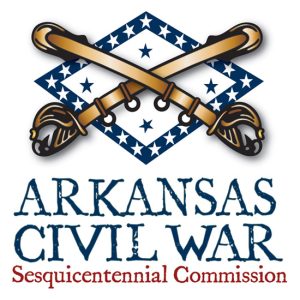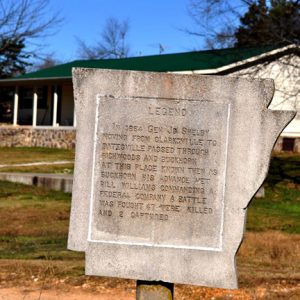calsfoundation@cals.org
Skirmish at Buck Horn
| Location: | Stone County |
| Campaign: | Campaign by General Kirby Smith to secure river ports in order to make troops east of the Mississippi River available for the Richmond Campaign |
| Date: | May 25, 1864 |
| Principal Commanders: | Bushwhacker Bill Williams (US); Brigadier General Joseph Shelby, Captain David A. Williams (CS) |
| Forces Engaged: | Bill Williams Irregulars (US); Captain David A. Williams, Jackman’s Brigade, Missouri, Shelby’s Cavalry Division (CS) |
| Estimated Casualties: | 47 killed, 2 captured (US); none (CS) |
| Result: | Confederate victory |
On May 5, 1864, Brigadier General Joseph Shelby was ordered from his position south of the Arkansas River to “occupy the valley of White River and to prevent its navigation in every possible manner and fashion.” Colonel Robert R. Livingston (US), who maintained a small detachment in Batesville (Independence County), had left Colonel John Stephens in command of the city, but in a letter dated May 11, 1864, Livingston advised Stephens of probable evacuation: “I may deem it best for you to evacuate Batesville, and should you find it necessary to do so, fall back upon this point,” being Jacksonport (Jackson County). Shelby and his Confederate troops moved from Clarksville (Johnson County) and crossed the Arkansas River at Dardanelle (Yell County) on May 18. Shelby paused there for recruitment by Colonels John T. Coffee and Sydney Drake Jackman. Meanwhile, Livingston evacuated Batesville on May 20 on news of Shelby’s approach, moving to Jacksonport. Shelby then passed through Dover (Pope County) and Clinton (Van Buren County), “over rough and sterile roads, over Blue and Ozark Mountains thru Richwoods,” across the ridge descending near Rocky Bayou Creek down through the farm of Colonel Thomas Black in present-day Stone County toward Buck Horn, now St. James (Stone County).
Captain David A. Williams of Shelby’s advance encountered Bill Williams and his ragtag group of bushwhackers—primarily Union deserters—on the ridge above Walls Ferry, where they were camping on May 25, 1864. Williams and his gang had taken advantage of the local men being away at war and had been terrorizing the Buck Horn area for some time. Mention of Bill Williams’s name reportedly “sent chills of terror into the hearts of people who were helpless against him; he and his men stopped at nothing.” From his camp near Wall’s Ferry, he stole, plundered, and murdered. Shelby described him as “the notorious Bill Williams who commanded a hybrid deserters, negros, women ravishers, and Federals.” Local militia under Colonel Thomas R. Freeman—including Jesse and Frank James, Jim Anderson, William Chitwood, Will Jones, John Younger, Henry Moore, Bill Knight, Charles Grigsby, John Freeman, Ike Flannery, Bill Arnold, Elbert Benbrook, Ben Gill, Bill Blankenship, John Byler, and others—were allowed to stay at home due to impending evacuation of Batesville. Freeman left these men at home to protect against Williams and to secure the munitions efforts. Many were upset over the capture of Franklin Criswell in February and Henderson Criswell in March at the hands of Williams while the men had been helping their family prepare for spring planting.
In the fight between Shelby and Williams, forty-seven of Williams’s men were killed, and two who were captured were executed the next day. Shelby’s report described the relief felt by the residents: “Young girls and old women met us the next day and called down Heaven’s blessings on my command for what they termed a glorious and righteous deed.” Shelby moved toward Batesville, which became Confederate headquarters, crossing the White River at Grigsby Ferry between present-day Marcella (Stone County) and O’Neal (Independence County) on May 26, 1864. Control over the White River remained the main objective in this area.
Rugged terrain and lack of provisions made the White River valley an undesirable place to do battle. More people had been killed in the Skirmish at Buck Horn than in any single battle anywhere near Batesville during the war. As Shelby approached Batesville, he got word that Livingston was in Jacksonport. He pushed his men riding through the night but was too late, for Livingston had evacuated Jacksonport on May 26. The war moved to the east to the Delta, where the rivers could be defended in an area much more suitable to sustain a large army.
For additional information:
Mobley, Freeman K. Making Sense of the Civil War in Batesville–Jacksonport and Northeast Arkansas. Batesville, AR: Frank K. Mobley, 2005.
Phillips, Freda Cruse. Places of Our People: Stories of the People and Places of the White River Valley. Kearney, NE: Morris Publishing, 2011.
The War of the Rebellion: A Compilation of the Official Records of the Union and Confederate Armies. Series 1, Vol. 34. Washington DC: Government Printing Office, 1891.
Freda Cruse Phillips
Mountain View, Arkansas








Comments
No comments on this entry yet.